Preparation of Oxysterols by C–H Oxidation of Dibromocholestane with Ru(Bpga) Catalyst
Abstract
:1. Introduction
2. Results
2.1. C–H Oxidation of 2-Ac with Ru(Bpga)
2.2. Oxidation of 2-Bz with Ru(Bpga) and Analysis of Products
2.3. Oxidation of 2-Bz with Fe (S,S-PDP) and Analysis of Products
2.4. Preparation of Hydroxycholesterols and Dihydroxycholesterols
3. Discussion
4. Materials and Methods
Oxidation of 2-Bz
5. Conclusions
Supplementary Materials
Author Contributions
Funding
Data Availability Statement
Conflicts of Interest
Sample Availability
References
- Björkhem, I. Are side-chain oxidized oxysterols regulators also in vivo? J. Lipid Res. 2009, 50, S213–S218. [Google Scholar] [CrossRef] [Green Version]
- Christenson, L.K.; McAllister, J.M.; Martin, K.O.; Javitt, N.B.; Osborne, T.F.; Strauss, J.F. Oxysterol Regulation of Steroidogenic Acute Regulatory Protein Gene Expression: Structural Specificity and Transcriptional and Posttranscriptional Actions. J. Biol. Chem. 1998, 273, 30729–30735. [Google Scholar] [CrossRef] [Green Version]
- Rodway, M.R.; Swan, C.L.; Crellin, N.K.; Gillio-Meina, C.; Chedrese, P.J. Steroid regulation of progesterone synthesis in a stable porcine granulosa cell line: A role for progestins. J. Steroid Biochem. Mol. Biol. 1999, 68, 173–180. [Google Scholar] [CrossRef]
- Radhakrishnan, A.; Ikeda, Y.; Kwon, H.J.; Brown, M.S.; Goldstein, J.L. Sterol-regulated transport of SREBPs from endoplasmic reticulum to Golgi: Oxysterols block transport by binding to Insig. Proc. Natl. Acad. Sci. USA 2007, 104, 6511–6518. [Google Scholar] [CrossRef] [Green Version]
- Hahn, C.; Reichel, C.; von Bergmann, K. Serum concentration of 7 alpha-hydroxycholesterol as an indicator of bile acid synthesis in humans. J. Lipid Res. 1995, 36, 2059–2066. [Google Scholar] [CrossRef]
- Ito, H.; Matsuo, K.; Hosono, S.; Watanabe, M.; Kawase, T.; Suzuki, T.; Hirai, T.; Yatabe, Y.; Tanaka, H.; Tajima, K. Association between CYP7A1 and the risk of proximal colon cancer in Japanese. Int. J. Mol. Epidemiol. Genet. 2010, 1, 35–46. [Google Scholar] [PubMed]
- Sato, H.; Nishida, S.; Tomoyori, H.; Sato, M.; Ikeda, I.; Imaizumi, K. Oxysterol Regulation of Estrogen Receptor α-Mediated Gene Expression in a Transcriptional Activation Assay System Using HeLa Cells. Biosci. Biotechnol. Biochem. 2004, 68, 1790–1793. [Google Scholar] [CrossRef] [PubMed]
- Spann, N.J.; Glass, C.K. Sterols and oxysterols in immune cell function. Nat. Immunol. 2013, 14, 893–900. [Google Scholar] [CrossRef]
- Sottero, B.; Rossin, D.; Staurenghi, E.; Gamba, P.; Poli, G.; Testa, G. Omics analysis of oxysterols to better understand their pathophysiological role. Free Radic. Biol. Med. 2019, 144, 55–71. [Google Scholar] [CrossRef]
- Chiappelli, J.; Quinton, M.S.; Volfson, D.; Cwik, M.; Marshall, W.; Bruce, H.; Goldwaser, E.; Kvarta, M.; Summerfelt, A.; Kochunov, P.; et al. Assessment of brain cholesterol metabolism biomarker 24S-hydroxycholesterol in schizophrenia. NPJ Schizophr. 2020, 6, 34. [Google Scholar] [CrossRef]
- Giorgi, V.; Menéndez, P.; García-Carnelli, C. Microbial transformation of cholesterol: Reactions and practical aspects—An update. World J. Microbiol. Biotechnol. 2019, 35, 131. [Google Scholar] [CrossRef]
- Barton, D.H.R.; Göktürk, A.K.; Jankowski, K. Functionalisation of saturated hydrocarbons. Part 3. The oxidation of 3β,5α,6β-triacetoxycholestane using the Gif system. J. Chem. Soc. Perkin Trans. 1 1985, 2109–2117. [Google Scholar] [CrossRef]
- Doiuchi, D.; Nakamura, T.; Hayashi, H.; Uchida, T. Non-Heme-Type Ruthenium Catalyzed Chemo- and Site-Selective C−H Oxidation. Chem. Asian J. 2020, 15, 762–765. [Google Scholar] [CrossRef] [Green Version]
- Doiuchi, D.; Uchida, T. Catalytic Highly Regioselective C–H Oxygenation Using Water as the Oxygen Source: Preparation of 17O/18O-Isotope-Labeled Compounds. Org. Lett. 2021, 23, 7301–7305. [Google Scholar] [CrossRef]
- Ogawa, S.; Kakiyama, G.; Muto, A.; Hosoda, A.; Mitamura, K.; Ikegawa, S.; Hofmann, A.F.; Iida, T. A facile synthesis of C-24 and C-25 oxysterols by in situ generated ethyl(trifluoromethyl)dioxirane. Steroids 2009, 74, 81–87. [Google Scholar] [CrossRef] [PubMed]
- Grob, C.A.; Winstein, S. Mechanismus der Mutarotation von 5,6-Dibromcholestan. Helv. Chim. Acta 1952, 35, 782–802. [Google Scholar] [CrossRef]
- Mauthner, J. Neue Beiträge zur Kenntnis des Cholesterins. Mon. Chem. Verwandte Teile And. Wiss. 1906, 27, 421–431. [Google Scholar] [CrossRef] [Green Version]
- Morzycki, J.W.; Sobkowiak, A. Electrochemical oxidation of cholesterol. Beilstein J. Org. Chem. 2015, 11, 392–402. [Google Scholar] [CrossRef] [PubMed] [Green Version]
- Maki, S.; Konno, K.; Takayama, H. Selective oxidation of terminal isopropyl groups to tertiary alcohols by electrochemical methodology. Tetrahedron Lett. 1997, 38, 7067–7070. [Google Scholar] [CrossRef]
- Bovicelli, P.; Lupattelli, P.; Mincione, E.; Prencipe, T.; Curci, R. Oxidation of natural targets by dioxiranes. 2. Direct hydroxylation at the side chain C-25 of cholestane derivatives and of vitamin D3 Windaus-Grundmann ketone. J. Org. Chem. 1992, 57, 5052–5054. [Google Scholar] [CrossRef]
- Van Lier, J.E.; Smith, L.L. Sterol metabolism. VII. Autoxidation of cholesterol via hydroperoxide intermediates. J. Org. Chem. 1970, 35, 2627–2632. [Google Scholar] [CrossRef]
- Chen Mark, S.; White, M.C. A Predictably Selective Aliphatic C–H Oxidation Reaction for Complex Molecule Synthesis. Science 2007, 318, 783–787. [Google Scholar] [CrossRef]
- White, M.C.; Zhao, J. Aliphatic C–H Oxidations for Late-Stage Functionalization. J. Am. Chem. Soc. 2018, 140, 13988–14009. [Google Scholar] [CrossRef] [PubMed]
- Mijares, A.; Cargill, D.I.; Glasel, J.A.; Lieberman, S. C-20 epimers of 20-hydroxycholesterol. J. Org. Chem. 1967, 32, 810–812. [Google Scholar] [CrossRef] [PubMed]
- Koreeda, M.; Koizumi, N. Stereochemically controlled synthesis of 20-isocholesterol. Tetrahedron Lett. 1978, 19, 1641–1644. [Google Scholar] [CrossRef]
- Honda, M.; Komori, T. Biologically active glycosides from Asteroidia. XI. Structures of thornasterols A and B. Tetrahedron Lett. 1986, 27, 3369–3372. [Google Scholar] [CrossRef]
- Stappenbeck, F.; Xiao, W.; Epperson, M.; Riley, M.; Priest, A.; Huang, D.; Nguyen, K.; Jung, M.E.; Scott Thies, R.; Farouz, F. Novel oxysterols activate the Hedgehog pathway and induce osteogenesis. Bioorg. Med. Chem. Lett. 2012, 22, 5893–5897. [Google Scholar] [CrossRef]
- Corman, A.; DeBerardinis, A.M.; Hadden, M.K. Structure-Activity Relationships for Side Chain Oxysterol Agonists of the Hedgehog Signaling Pathway. ACS Med. Chem. Lett. 2012, 3, 828–833. [Google Scholar] [CrossRef] [PubMed] [Green Version]
- Hu, P.; Peters, B.K.; Malapit, C.A.; Vantourout, J.C.; Wang, P.; Li, J.; Mele, L.; Echeverria, P.-G.; Minteer, S.D.; Baran, P.S. Electroreductive Olefin-Ketone Coupling. J. Am. Chem. Soc. 2020, 142, 20979–20986. [Google Scholar] [CrossRef]
- Sugawara, T.; Nomura, E.; Fujimoto, S. Expression of enzyme associated with steroid hormone synthesis and local production of steroid hormone in endometrial carcinoma cells. J. Endocrinol. 2004, 180, 135–144. [Google Scholar] [CrossRef] [Green Version]
- Ohgane, K.; Karaki, F.; Noguchi-Yachide, T.; Dodo, K.; Hashimoto, Y. Structure-activity relationships of oxysterol-derived pharmacological chaperones for Niemann-Pick type C1 protein. Bioorg. Med. Chem. Lett. 2014, 24, 3480–3485. [Google Scholar] [CrossRef] [PubMed]


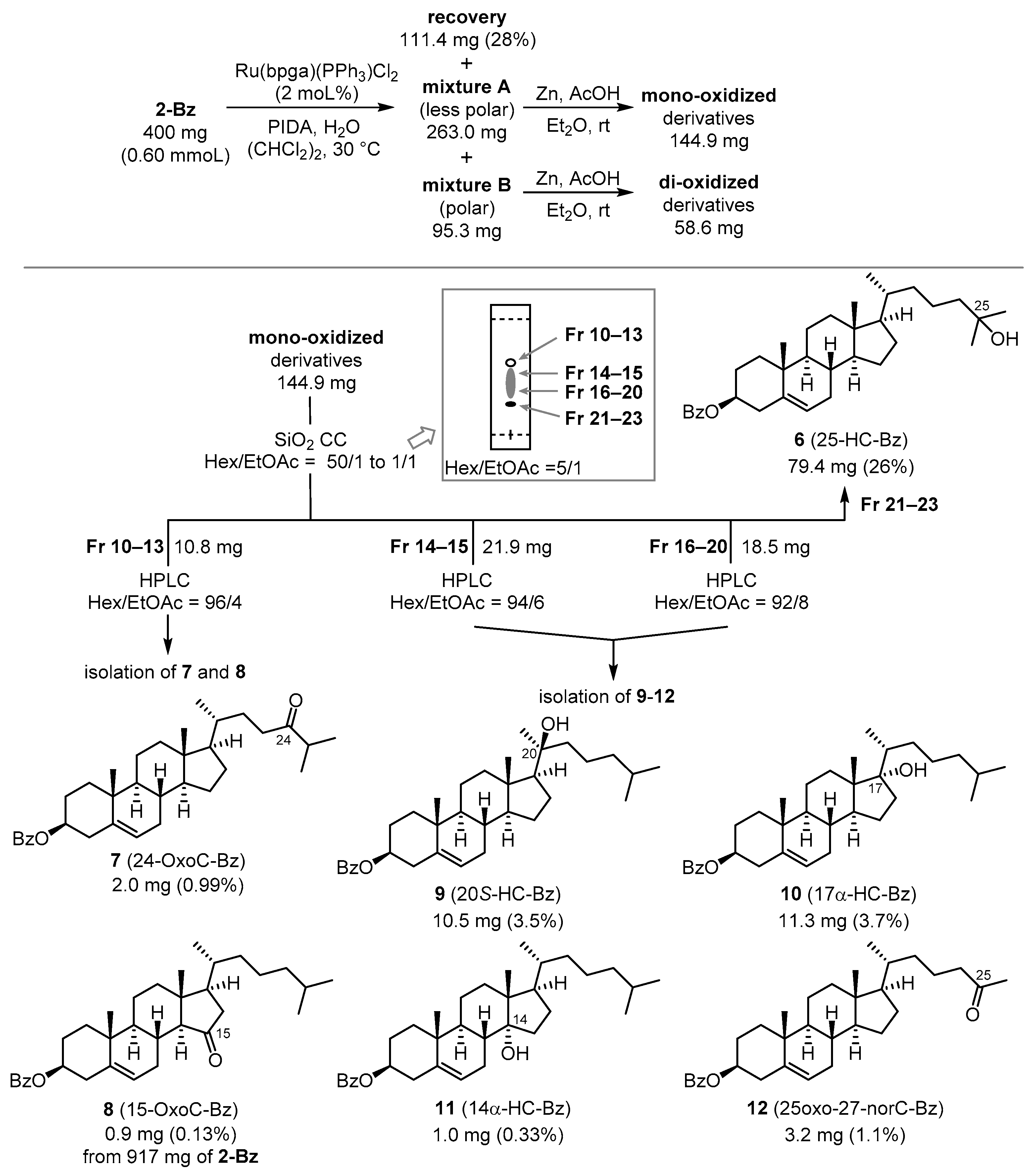


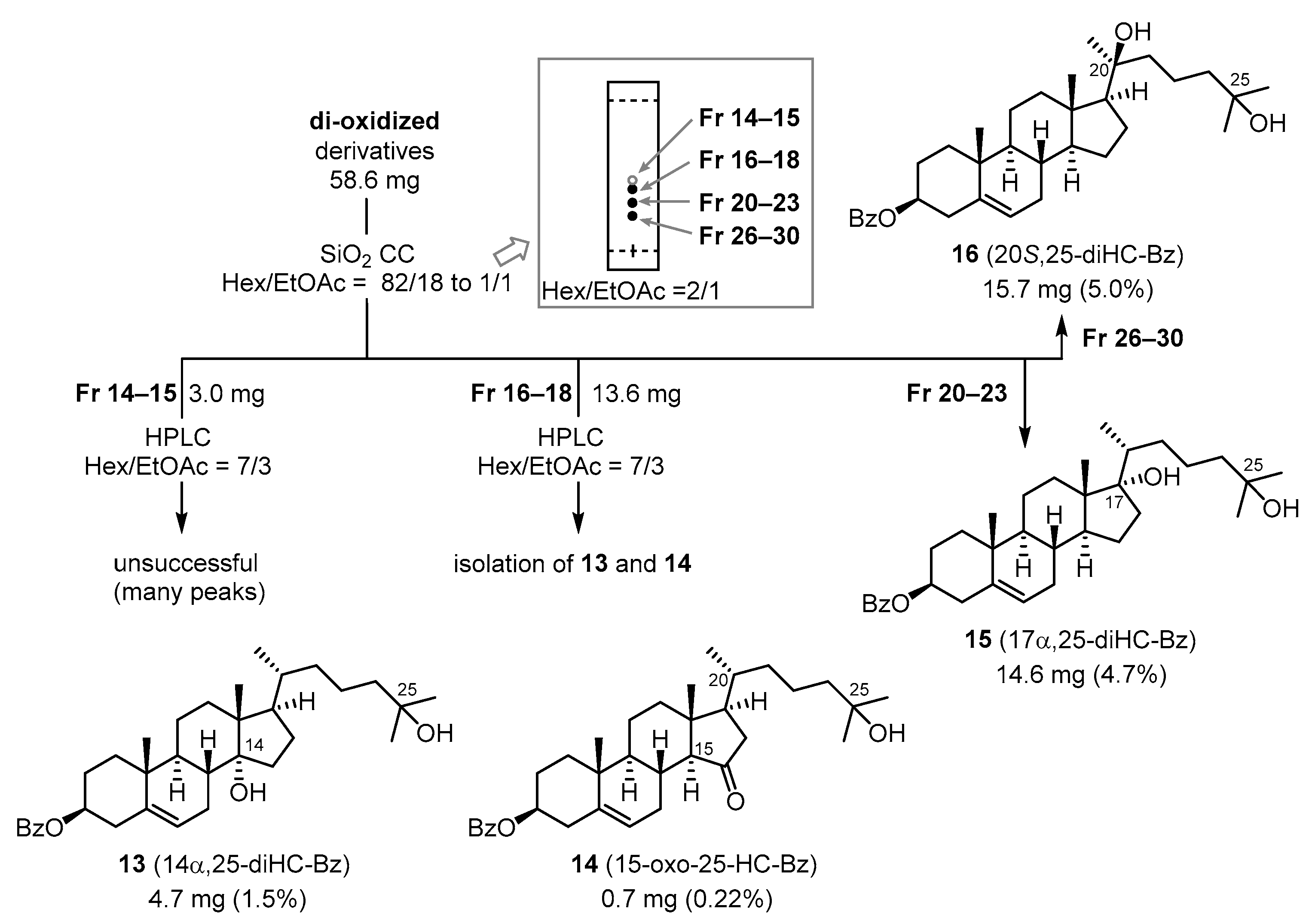

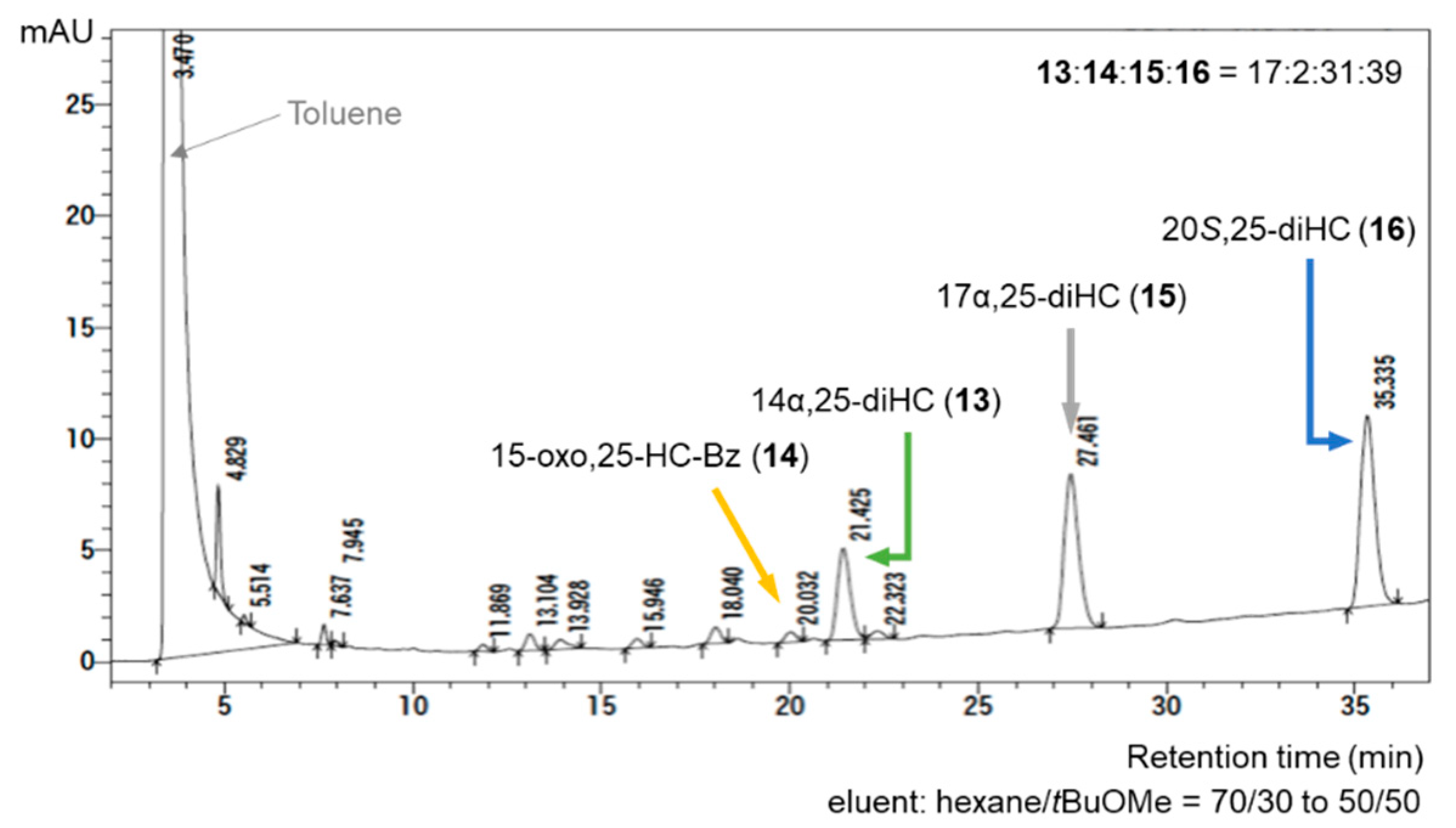

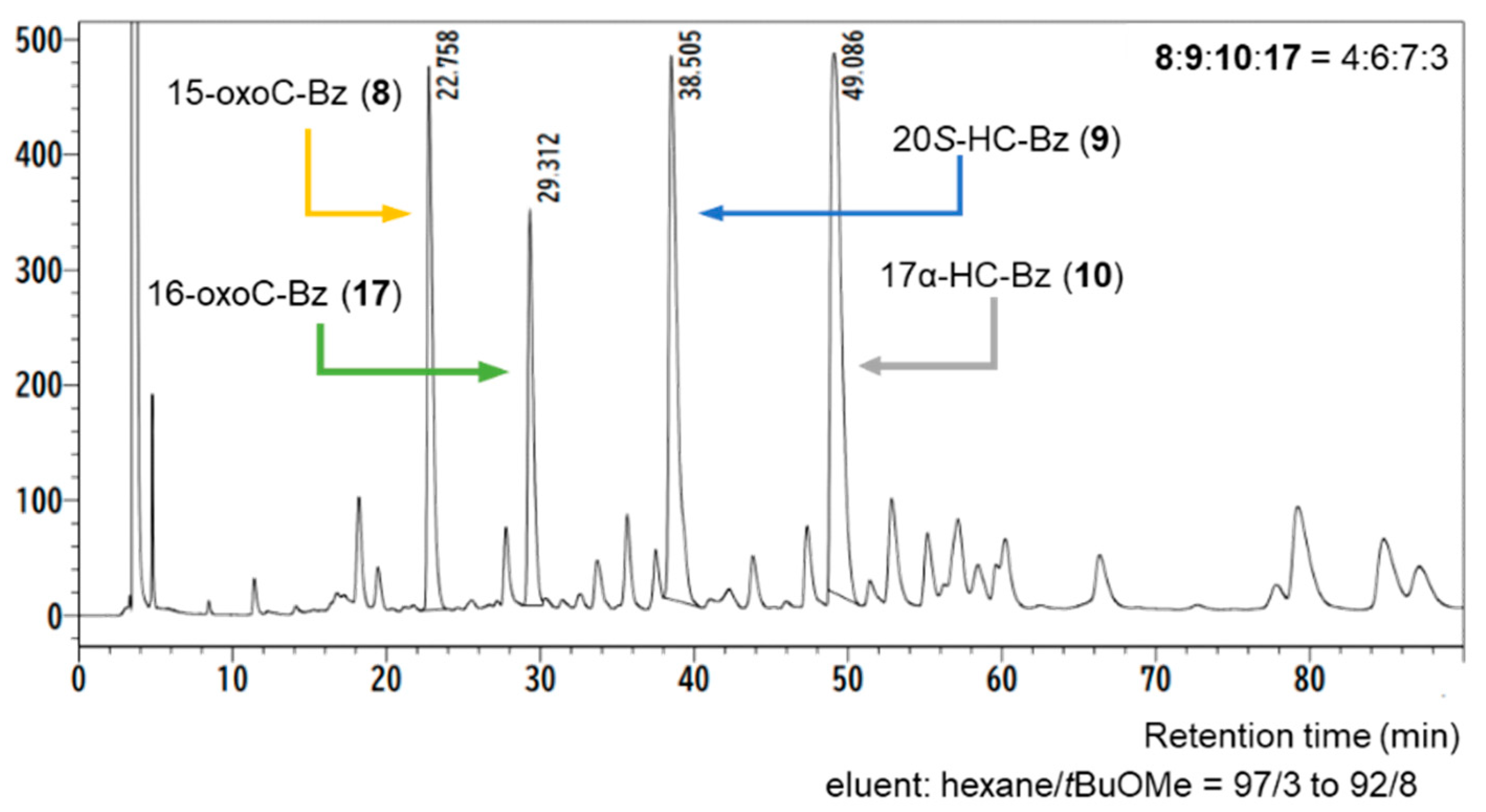

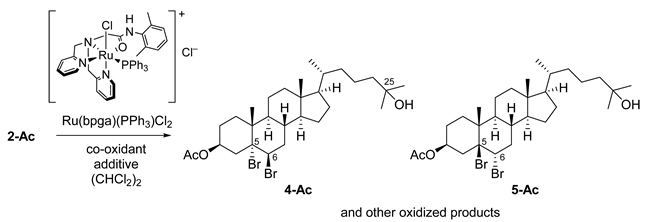
| Entry | Oxidant | Additive (Equivalent) | Time (h) | Yields | ||
|---|---|---|---|---|---|---|
| 4-Ac | 5-Ac | Recovery | ||||
| 1 1 | PhIO 2 | TFA (0.1) | 70 | 9 | 17 | 19 |
| 2 1 | PhIO 2 | TFA (0.2) | 43.5 | 13 | 15 | 22 |
| 3 1 | PhIO 2 | TFA (0.4) | 43.5 | 10 | 15 | 28 |
| 4 1 | PhIO 2 | TFA (1.0) | 21.5 | 7 | 9 | 47 |
| 5 3 | PhIO 2 | TFA (0.1) | 94.5 | 8 | 14 | 37 |
| 6 3 | mCPBA | None | 92 | 4 | 9 | 58 |
| 7 3 | PIDA | H2O (2.8) | 92 | 10 | 24 | 26 |
Publisher’s Note: MDPI stays neutral with regard to jurisdictional claims in published maps and institutional affiliations. |
© 2021 by the authors. Licensee MDPI, Basel, Switzerland. This article is an open access article distributed under the terms and conditions of the Creative Commons Attribution (CC BY) license (https://creativecommons.org/licenses/by/4.0/).
Share and Cite
Fujii, Y.; Yoritate, M.; Makino, K.; Igawa, K.; Takeda, D.; Doiuchi, D.; Tomooka, K.; Uchida, T.; Hirai, G. Preparation of Oxysterols by C–H Oxidation of Dibromocholestane with Ru(Bpga) Catalyst. Molecules 2022, 27, 225. https://doi.org/10.3390/molecules27010225
Fujii Y, Yoritate M, Makino K, Igawa K, Takeda D, Doiuchi D, Tomooka K, Uchida T, Hirai G. Preparation of Oxysterols by C–H Oxidation of Dibromocholestane with Ru(Bpga) Catalyst. Molecules. 2022; 27(1):225. https://doi.org/10.3390/molecules27010225
Chicago/Turabian StyleFujii, Yui, Makoto Yoritate, Kana Makino, Kazunobu Igawa, Daiki Takeda, Daiki Doiuchi, Katsuhiko Tomooka, Tatsuya Uchida, and Go Hirai. 2022. "Preparation of Oxysterols by C–H Oxidation of Dibromocholestane with Ru(Bpga) Catalyst" Molecules 27, no. 1: 225. https://doi.org/10.3390/molecules27010225






